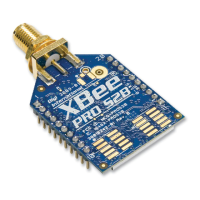Definitions
XBee/XBee-PRO ZigBee RF Modules User Guide 182
Joining The process of a node becoming part of a ZigBee PAN. A node becomes part of a network by
joining to a coordinator or a router (that has previously joined to the network). During the
process of joining, the node that allowed joining (the parent) assigns a 16-bit address to the
joining node (the child).
Network Address The 16-bit address assigned to a node after it has joined to another node. The coordinator
always has a network address of 0.
Operating Channel The frequency selected for data communications between nodes. The operating channel is
selected by the coordinator on power-up.
Energy Scan A scan of RF channels that detects the amount of energy present on the selected channels. The
coordinator uses the energy scan to determine the operating channel.
Route Request Broadcast transmission sent by a coordinator or router throughout the network in attempt to
establish a route to a destination node.
Route Reply Unicast transmission sent back to the originator of the route request. It is initiated by a node
when it receives a route request packet and its address matches the Destination Address in the
route request packet.
Route Discovery The process of establishing a route to a destination node when one does not exist in the Routing
Table. It is based on the Ad-hoc On-demand Distance Vector routing (AODV) protocol.
ZigBee Stack ZigBee is a published specification set of high-level communication protocols for use with small,
low-power modules. The ZigBee stack provides a layer of network functionality on top of the
802.15.4 specification.
For example, the mesh and routing capabilities available to ZigBee solutions are absent in the
802.15.4 protocol.

